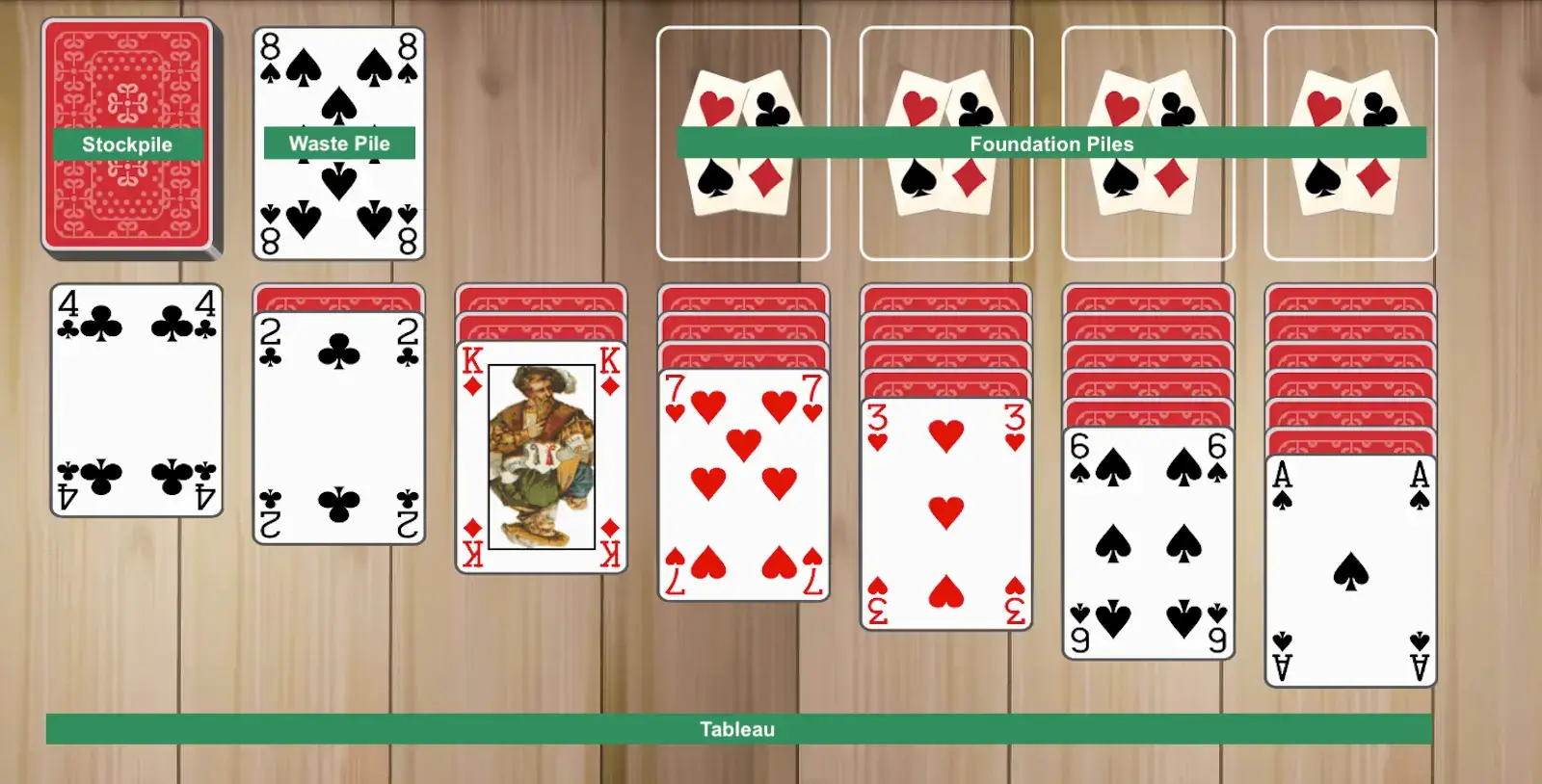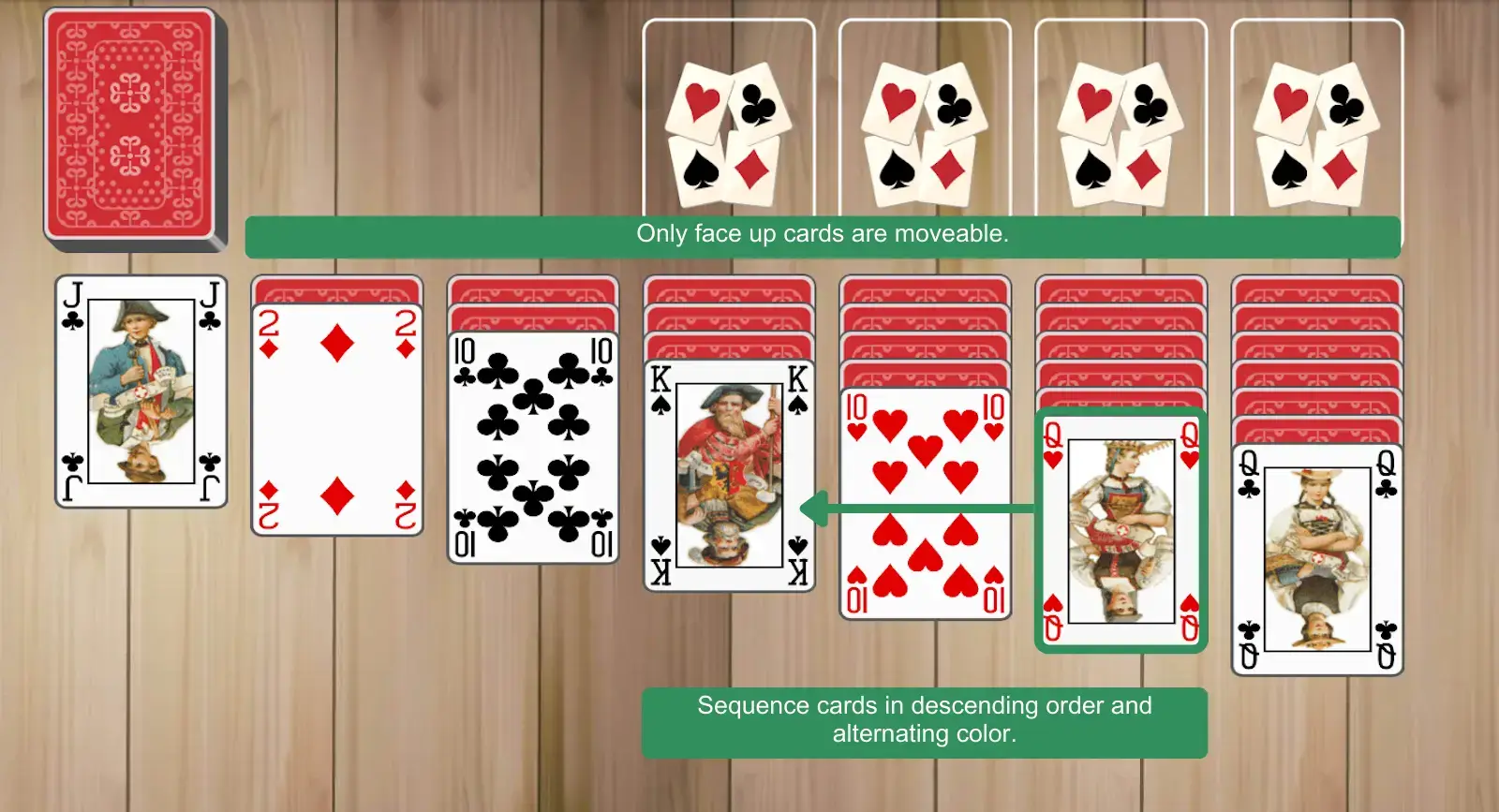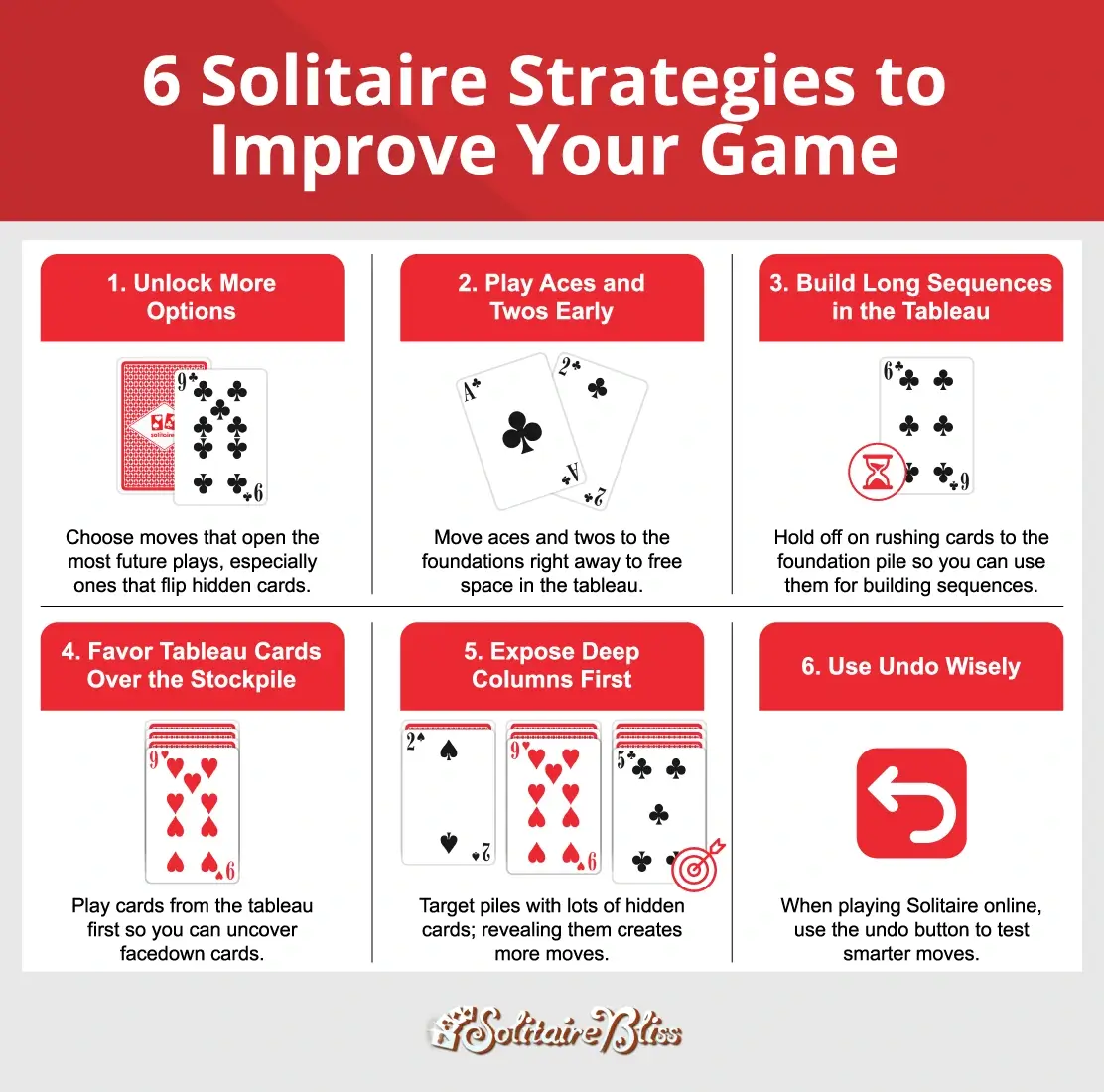How to Play Solitaire: Rules and Strategies for Beginners
Solitaire, also known as Klondike or Patience, is one of the most popular single-player card games in the world. Played with a standard 52-card deck, the goal is straightforward: Complete the four foundation piles, starting with the ace and ending with the king for each suit. Once you have done that for all four suits, you have won the game.
We dive into more detailed Solitaire rules below, but these are the key things you should know:
- Foundations are built by suit, starting with the ace and ending with the king.
- Tableau piles are arranged in descending order while alternating colors (red on black, black on red).
- Empty columns can only be filled with a king or a sequence starting with a king.
In this guide, you’ll learn how to set up the game, follow the rules, and apply smart strategies that increase your chances of winning, whether you’re playing Solitaire online or with a deck of cards. We’ll also explore a few popular variations, like Spider, FreeCell, and Pyramid, so you can expand your play once you’ve mastered the classic version.
Solitaire Objective
The goal of Solitaire is to move all 52 cards into four foundation piles, one for each suit, building them in ascending order from ace to king. The game is won after all four foundations are complete.
Solitaire Setup
To begin a game of Solitaire, you’ll need a standard 52-card deck and a layout with four distinct areas:
- The tableau: Seven columns where most of the gameplay happens
- The foundations: Four empty piles above the tableau, one for each suit, where you’ll eventually build from ace through king
- The stockpile: The stack of leftover cards you’ll draw from during play
- The waste pile: The face-up pile created when you draw from the stock

- Shuffle the deck thoroughly.
- Deal the tableau from left to right, one card at a time that follows the pattern below, until you have seven columns.
- Flip one card face up into the first column, and then deal a facedown card into all other columns.
- Flip one card face up onto the second column, and then deal a facedown card into all columns to the right.
- Flip one card face up onto the third column, and then deal a facedown card into all columns to the right.
- Continue this pattern until the last column has six cards facedown and one card face up.
- Place the remaining undealt cards face down in the stockpile at the top left.
- Leave space for a waste pile next to the stock, which will form as you draw cards during play.
- Leave four spaces for the foundation piles above the tableau, one for each suit.
At the end of setup, you’ll see seven tableau columns across the bottom, the stockpile and waste pile in the top corner, and four empty foundation spaces waiting to be built.
Solitaire Rules
The rules of Solitaire are straightforward:
- Only face-up cards can be moved.
- Tableau piles must be built in descending order, alternating colors (e.g. red seven on black eight).
- Foundation piles begin with an ace and must be built upward in the same suit, ace through king.
- You may move single cards or sequences of properly ordered cards within the tableau.
- When a move exposes a facedown card, flip it face up.
- Empty tableau columns can only be filled with a king or a sequence starting with a king.
- Cards are drawn from the stockpile into the waste pile, and only the top card of the waste is playable.
- When the stockpile is empty, flip the waste pile over to create a new stock, without shuffling.
- The stockpile can be used as often as needed.
- The game is won when all four foundations are complete.
How to Play Solitaire (Step by Step)
Now that you know the rules, here’s how they come together in play:
1. Look Over the Tableau and Make Your First Moves
At the start, only the last card in each tableau pile is face up. These are the only cards you can move. If you see an ace, move it immediately to start a foundation pile. You can also move cards between tableau piles, but they must go in descending order (a lower card on a higher card) and alternating color (a red card on a black card, or a black card on a red card). For example, you can place a red Q♥ on top of a black K♠.

2. Begin Building the Foundations
The foundations must always start with an ace, then build upward in the same suit, ace to king. For example, once the ace of hearts is in the foundation, you can add the two of hearts, then the three of hearts, and so on. You cannot mix suits. If you have an ace of spades, only spades can be stacked on that pile.
3. Rearrange the Tableau to Uncover Hidden Cards
Your goal in the tableau is to reveal as many facedown cards as possible by moving cards from tableau piles. You can move single cards or groups of cards, as long as they remain in descending order with alternating colors.
For example, you might have a Q♥, J♠, and 10♦ stacked together. You can move the whole group onto a black king. Every time you move a card and expose a facedown card, flip it face up so it becomes playable. Always aim to make moves that help you uncover hidden cards or create room for new plays.

4. Use Empty Spaces Wisely (Only Kings Can Go There)
If you clear out an entire tableau column, it leaves an empty space. Only a king (or a group of cards starting with a king) can be moved into that empty spot. Opening a space is powerful because it gives you room to reorganize cards and unlock more hidden ones.
5. Draw From the Stockpile When Stuck
If you run out of moves in the tableau, draw cards from the stockpile into the waste pile. Only the top card of the waste pile can be played. For example, the K♣ can be moved to the empty column and the Q♦ can go on top of it, uncovering a new card in column five.
You can choose from two common variations for drawing:
- Turn 1 (one-card draw): Turn over one card at a time. If it can be played, move it to a tableau pile or foundation.
- Turn 3 (three-card draw): Flip over three cards at once onto the waste pile. Only the top card is playable at first. If you play it, the next card beneath becomes available, and so on. This variation is more challenging because you can’t reach every card right away.
When the stockpile runs out, flip the waste pile over to form a new stock. Do not shuffle; just simply turn it over and continue playing.You can cycle through the stockpile as often as you want.

6. Keep Repeating the Cycle
Keep scanning the tableau, building foundations, and drawing from the stock until you either complete all four foundations or run out of legal moves. You win the game when every card is in the foundations, neatly stacked from ace to king in each suit.
Can You Win Every Solitaire Game?
While there is sometimes luck involved when it comes to winning a game of Solitaire, the game is more winnable than most people think. Although sometimes cards are dealt in such a way to make it impossible to win, one study found that between 82% and 91% of Klondike Solitaire games are winnable. You can improve your odds by learning some strategies to win Solitaire consistently.
Solitaire Game Strategies
You can try many approaches to playing Solitaire, but we highlight a few of the most common strategies in this list:

- Prioritize moves that unlock the most options. Instead of automatically making the first move you see, think about which move will open up the most future plays, especially those that uncover facedown cards in the tableau.
- Play aces and twos to the foundations right away. Moving these early frees up space in the tableau and gives you more flexibility to maneuver other cards.
- Don’t rush higher cards to the foundations. Sending a five or six to the foundations too soon might block sequences you still need to build in the tableau. Try to build foundations somewhat evenly across suits so you don’t run out of options in one color too early.
- Prioritize tableau cards over the stockpile. If you know a red seven is in the stockpile, but you have one in the tableau that can be played on a black eight, use the tableau card. Using tableau cards allow you to uncover hidden cards, which you can’t do with the stockpile.
- Target columns with the most facedown cards. The faster you expose hidden cards, the more moves become available. Focus on uncovering deep stacks before clearing out smaller, already-revealed piles.
- Use the undo button thoughtfully. When you’re playing Solitaire online or in an app, the undo feature is a great way to explore different paths. Use it to test moves or correct mistakes, but don’t rely on it for every decision.
Solitaire Variations
This guide deals with Klondike Solitaire, but you can also play many Solitaire variations. Try these other types of Solitaire games if you want to switch things up:
- Spider: Played with two decks and 10 tableau columns, this variation is more difficult than Klondike. Instead of moving cards to foundations right away, your goal is to build complete sequences from king down to ace within the tableau. Only same-suit sequences can be moved as a unit, and using the stockpile places a face-up card at the bottom of each column.
- FreeCell: Every card is dealt face up into eight tableau columns, so luck plays a smaller role. The twist: You have four “free cells” above the tableau that act as temporary storage for cards, which gives more flexibility to unlock new plays. Nearly every FreeCell deal is solvable with the right strategy.
- Yukon: This variation is similar to Klondike but without a stockpile. All cards are dealt at the start, and you can move groups of cards regardless of how they’re stacked, as long as the bottom card is placed on a card one rank higher and the opposite color. This makes Yukon more flexible but also trickier to unlock cards within columns.
- Forty Thieves: Played with two decks and ten tableau columns of four cards each, the rules are strict. You build tableau piles down in suit only, and only one card can be moved at a time. It’s one of the toughest Solitaire variations to win.
- Golf: The goal isn’t to build foundations at all, but to clear the tableau by moving cards onto a single foundation pile in sequence, either one rank higher or one rank lower than the current card. Strategy comes from planning ahead to avoid being stuck.
- Pyramid: Cards are dealt in a pyramid shape, and the objective is to remove pairs of exposed cards that add up to 13. Kings can be removed on their own. The game ends when you clear the pyramid or run out of moves.
Start Playing Solitaire!
Ready to get started playing Solitaire? It’s easy: You can play Solitaire online or with a standard deck of cards (52 in total). Once you master Klondike, try many other variations for free on Solitaire Bliss.
Back to the Homepage

